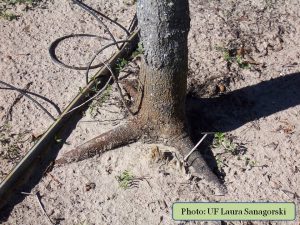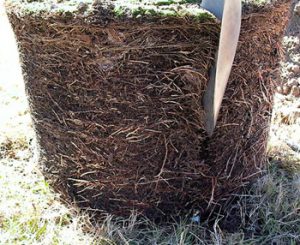It is a common misconception that winter is a time of rest in the landscape, for both plants and people. In the Panhandle, the winter months tend to be rainy and miserable, with wild weather fluctuations in between. These conditions cause folks to think their chores are done until the weather warms up and plants begin to grow again. In reality, winter lays the foundation for the next year of growth! This is because, though most plants are dormant or have at least slowed their growth above ground, their root systems continue to develop through the cold. This “catch-up” time when plants are not growing above ground is the ideal time to plant woody trees and shrubs so they can focus their energy on getting a root system established without having to worry about supporting shoot growth! However, even if you plant at the proper time, several common mistakes can still torpedo your planting efforts. I once worked for a snarky nurseryman who, when new employees would ask how he wanted trees to be planted, would answer, “Green side up, of course.” So, remember to plant green side up and also keep the following in mind when you plant this winter!
- Digging the right hole. The quickest way to resign a plant to failure before even removing it from the container is to dig a bad hole. In order to facilitate ideal root development and allow the plant to establish as rapidly as possible, the planting hole should be 2-3 times the diameter of the rootball. The easiest way to measure this is to set the plant were you want it and begin digging the hole around it; this step allows you to visualize the size of the hole. Most holes that are “eyeballed” are not wide enough. A little extra digging in the beginning can make a lot of difference later. In addition, the planting hole should be, at minimum, the same depth as the rootball. In a perfect scenario, after planting, the top of the rootball should be a half an inch to an inch higher than the surrounding soil to accommodate for settling of the soil underneath the rootball. This prevents the plant from sitting in a depression that water could pool in, leading to disease issues. It can be hard to believe, but simply digging a proper hole helps ensure plant establishment and enables long-term survival!
- Preventing Circling Roots. Often, plants are constrained in a container that is a little too small for a little too long on the floor of a nursery. When this situation occurs, the roots of the plant do not stop growing once they reach the “wall” of the container, but rather keep going in a circular pattern around the edge of the pot. This is a problem because, if not corrected, the roots will continue this growth pattern once in the ground, eventually strangling the plant. However, this problem is easily corrected by severing the circling roots. This is where gardeners often get squeamish however. It is time to check your plant conscience at the door and know the plant will thank you later! I like to make vertical slices, evenly spaced, around the rootball. These slices should cut about an inch into the rootball to ensure both superficial and unseen circling roots are cut; this somewhat brutal task can be accomplished with a sharp shovel, machete, or even a heavy-duty pair of pruners. At every cut, the previously circling root will branch, creating a nice web of new roots that will serve as anchors for the fledgling plant.
 Backfilling Correctly. The single most asked question involving plants trees and shrubs is, “Should I backfill the hole with compost?” The single most common answer I give in return is, “Absolutely not.” Although it seems counterintuitive, it is almost never a good idea to backfill with a soil that is not your native soil. There is a simple reason for this. If a tree were planted in a hole that is backfilled with rich soil and is surrounded by our infertile, native Florida sands, why would it ever want to leave that hole? Turns out, it does not want to leave that easy environment because it has all the nutrients it needs right there, which is a problem. What happens when a drought, hurricane, or other stress event comes calling? The plant will not have a wide-spreading root system for support and will suffer from lack of water or lodging from high winds. By backfilling with your native soil, you encourage the plant’s roots to grow out and seek water and nutrients.
Backfilling Correctly. The single most asked question involving plants trees and shrubs is, “Should I backfill the hole with compost?” The single most common answer I give in return is, “Absolutely not.” Although it seems counterintuitive, it is almost never a good idea to backfill with a soil that is not your native soil. There is a simple reason for this. If a tree were planted in a hole that is backfilled with rich soil and is surrounded by our infertile, native Florida sands, why would it ever want to leave that hole? Turns out, it does not want to leave that easy environment because it has all the nutrients it needs right there, which is a problem. What happens when a drought, hurricane, or other stress event comes calling? The plant will not have a wide-spreading root system for support and will suffer from lack of water or lodging from high winds. By backfilling with your native soil, you encourage the plant’s roots to grow out and seek water and nutrients.
As you can see, there is a little more to planting than “green side up.” But, if you plant at the right time, dig the right hole, prevent circling roots, and backfill with your native soil, you will have set your newly bought tree or shrub up for success and will be able to enjoy it for many years to come! For more information on planting and other horticultural topics, contact your local UF/IFAS Extension office and as always, happy gardening!
- Easy Spring Color with Petunias - April 5, 2024
- Blue Blooming Beauties of the Florida Panhandle - October 26, 2023
- When It’s Too Hot to Garden. What to Do? - August 24, 2023

